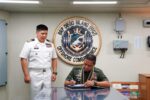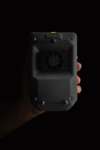Schiebel has officially unveiled its next-generation vertical takeoff and landing (VTOL) unmanned aerial vehicle (UAV), the CAMCOPTER S-300, during a demonstration in South Korea. This marks a significant evolution from the widely used CAMCOPTER S-100 and signals Schiebel’s intent to expand into heavier payload naval ISR roles. The event also highlights growing interest from the Republic of Korea Navy (ROKN) in indigenous and allied UAV capabilities for maritime domain awareness.
Next-Gen VTOL Platform Emerges
The CAMCOPTER S-300 was showcased publicly for the first time at an event hosted by Korean defense firm Hanwha Systems at Goheung Aerospace Center. The aircraft had previously been under wraps since its quiet rollout in 2022. The new system builds on the operational legacy of the CAMCOPTER S-100 but introduces significantly improved payload capacity, range, and mission flexibility.
According to Schiebel representatives at the event and supporting materials reviewed by MiliVox, the CAMCOPTER S-300 is designed as a Group 4-class tactical UAV with a maximum takeoff weight (MTOW) of 250 kg—more than double that of the 110 kg MTOW of the S-100. It retains a similar airframe profile but is substantially larger and optimized for modular payload integration.
The aircraft is powered by a heavy-fuel engine compatible with JP-5/JP-8 naval fuels—a key requirement for shipboard operations—allowing it to operate seamlessly alongside manned platforms on naval vessels without requiring separate fuel logistics chains.
Enhanced Payloads and Mission Profiles
The increased MTOW allows the CAMCOPTER S-300 to carry up to 50 kg of mission equipment compared to approximately 34 kg on the S-100. This opens up options for more capable electro-optical/infrared (EO/IR) turrets such as Wescam MX-series or Hensoldt ARGOS II HDT systems, synthetic aperture radar (SAR), electronic intelligence (ELINT) packages, or even lightweight sonobuoy dispensers for anti-submarine warfare (ASW) support roles.
Endurance has also been extended significantly. While official figures remain undisclosed pending final testing certifications, industry sources suggest mission durations exceeding 6 hours are achievable depending on configuration—compared to around 6 hours max endurance of the lighter-loaded S-100. Range is expected to exceed 200 km line-of-sight when paired with appropriate datalink systems.
This makes it particularly suitable for long-range maritime surveillance missions such as exclusive economic zone (EEZ) patrols, vessel tracking and interdiction support, or over-the-horizon targeting cueing for surface combatants equipped with long-range precision weapons.
South Korean Interest Signals Regional Demand
The unveiling in South Korea was not incidental. Hanwha Systems has been collaborating with Schiebel since early 2023 under an MoU aimed at co-developing advanced unmanned systems tailored to Republic of Korea Navy requirements. The ROKN has expressed growing interest in VTOL UAVs capable of operating from destroyers and future frigates under its “KDDX” next-gen destroyer program.
Currently reliant on manned helicopters such as AW159 Wildcats and UH variants for airborne ISR and ASW roles aboard ships like KDX-II/III destroyers or FFX frigates, Seoul sees unmanned alternatives as force multipliers that reduce pilot risk while expanding persistent coverage.
The ROKN has previously trialed rotary-wing drones including UMS Skeldar V200 and domestic platforms like KUS-VH developed by KAI. However, none have yet reached full operational deployment across fleet units due largely to integration challenges or limited performance envelopes. The CAMCOPTER S-series—with proven maritime credentials—offers a low-risk path toward near-term capability fielding.
S-Series Evolution: From Tactical ISR to Strategic Utility
The original CAMCOPTER S-100 entered service nearly two decades ago and has since logged over 100,000 flight hours globally across more than two dozen navies including France’s Marine Nationale and Italy’s Marina Militare. Its compact footprint made it ideal for small deck operations without catapults or arresting gear.
The new S-300 variant preserves this operational DNA while scaling up performance parameters into a higher class segment—bridging tactical VTOL drones like Skeldar V200 or V-BAT with larger fixed-wing MALE-class systems like MQ-9B SeaGuardian that require runways or shipboard launch/recovery systems.
- MTOW: ~250 kg
- Payload: Up to 50 kg
- Endurance: Estimated >6 hours
- Datalink Range: >200 km LOS
- Fuel Type: JP5/JP8 heavy fuel engine
This positions it well not only for traditional EO/IR surveillance but also multi-domain applications including ELINT/SIGINT collection near contested coastlines (e.g., North Korea), communications relay nodes during amphibious operations or disaster relief scenarios where terrestrial infrastructure is degraded.
Tactical Integration Challenges Remain
A key hurdle remains seamless integration into existing C4ISR architectures aboard ROKN vessels. While Hanwha Systems is expected to provide bespoke mission control consoles compatible with domestic CMS frameworks such as those found onboard KDX-class ships, full sensor fusion with Link-K tactical datalinks remains an ongoing development goal.
This will be critical if platforms like the CAMCOPTER are expected not just to collect data but actively cue kinetic fires from shipborne missiles or coordinate with other assets via manned-unmanned teaming concepts—a direction increasingly emphasized by NATO navies operating similar Class III-IV UAS platforms offshore Europe and Indo-Pacific theaters alike.
A Competitive Global Landscape
The CAMCOPTER S-300 enters an increasingly crowded market segment where competitors include Leonardo’s AWHero RUAS (~200 kg MTOW), UMS Skeldar V200 (~235 kg MTOW), Northrop Grumman’s MQ-8C Fire Scout (~1430 kg MTOW), and Anduril’s Ghost series hybrid drones targeting expeditionary forces. Each offers varying trade-offs between endurance, payload capacity, autonomy levels and deck compatibility features such as folding rotors or automated recovery aids.
Schiebel’s competitive edge lies in its established logistics chain from years of global fielding experience with navies operating off corvettes/frigates without major modifications—a factor likely attractive not only to Seoul but also regional partners such as Indonesia or Philippines seeking cost-effective maritime ISR solutions amid rising tensions in East Asia littorals.
Outlook: Toward Operational Trials & Export Campaigns
No formal procurement contract has yet been announced by South Korean defense authorities; however multiple sources indicate sea trials aboard ROKN vessels may commence within CY2025 following further integration work led by Hanwha Systems’ drone division based out of Pangyo Techno Valley innovation cluster near Seoul.
If successful—and assuming favorable cost-performance metrics—the platform may be offered under Foreign Military Sales arrangements via Austria-South Korea bilateral channels or through regional marketing campaigns targeting ASEAN navies modernizing their coastal surveillance fleets post-COVID budget recoveries.
Sources
- “CAMCOPTER® S-300 Breaks Cover in South Korea” – Naval News – https://www.navalnews.com/naval-news/2025/10/camcopter-s-300-breaks-cover-in-south-korea/
- “Schiebel Unveils New Heavy-Fuel Powered VTOL Drone” – Janes Defence Weekly – https://www.janes.com/defence-news/news-detail/schiebel-unveils-new-heavy-fuel-powered-vtol-drone
- “Hanwha Signs MOU With Schiebel For Naval Drone Development” – Defense Times Korea – https://www.defensetimes.kr/article/view.php?idx=12345
- “CAMCOPTER® Family Overview” – Schiebel Official Site – https://schiebel.net/products/camcopter-s-series










